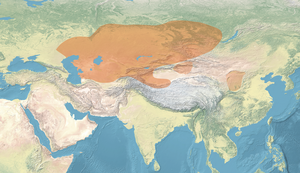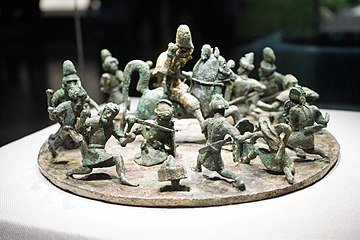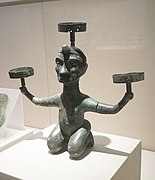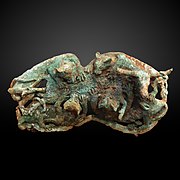Dian Kingdom
Dian Điền | |||||||
|---|---|---|---|---|---|---|---|
| 8th century BCE[1]–109 BCE[1] | |||||||
 Dian and the southwestern peoples in the early Han period. Red means nomadic, yellow is semi-nomadic, and purple is sedentary. | |||||||
 Dian Kingdom horserider, from a bronze cowry container. | |||||||
| Capital | Today'sJinning District 24°40′00″N102°35′30″E/ 24.666667°N 102.591667°E | ||||||
| Government | Monarchy | ||||||
| History | |||||||
• Established | 8th century BCE[1] | ||||||
•Annexedby theHan dynasty | 109 BCE[1] | ||||||
| |||||||
| Today part of | China | ||||||
Dian(Chinese:Điền) was an ancient kingdom established by the Dian people, a non-Hanmetalworking civilization that inhabited around theDian Lakeplateau of central northernYunnan,Chinafrom the lateSpring and Autumn perioduntil theEastern Han dynasty.The Dian buried their dead in vertical pit graves.[2]The Dian language was likely one of theTibeto-Burman languages.[3]The Han Empire's annexation of the Dian Kingdom in 109 BCE eventually led to the establishment of the Yizhou commandery. Dian culture started from at least the 8th century BCE, until it fellunder the controlof theHan dynastyin 109 BCE.[1]
History[edit]

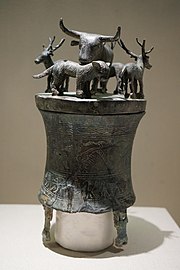
Dian was an ancient kingdom situated in modernYunnan,southwestern China, in the region around theDian Lake.According to Han historian,Sima Qian,it was established in 279 BCE whenKing Qingxiang of Chusent a military force to the southwest. Zhuang Qiao, a general ofChu,reached theDian Lakeas part of the Chu military campaign. When the Chu homeland was invaded by theQin,Zhuang Qiao decided to stay in Yunnan and adopt the native ways, establishing the Dian kingdom. TheQin dynastywas subsequently overthrown by the Han, and the commanderies of the new dynasty, Ba and Shu, bordered Dian.[4][5][6][7]
According to theShiji,the southwest was dominated by barbarians, among whom the ruler ofYelangwas the most powerful. To the west of Yelang were the Mimo and the most powerful among them was the ruler of Dian. North of Dian was Qiongdu. All these people styled their hair in a mallet-shaped fashion. These were settled peoples who worked the fields and lived in settlements.[8][9]
In the area fromTongshieast toYeyuwere the Sui andKunmingtribes who braided their hair and moved from place to place with their herds. They had no fixed abodes or rulers. Northeast of the Sui were the Xi and Zuodu. The most powerful of the Zuodu were the Ran and Mang, who lived west ofShu.Some of them moved from place and place but others lived in fixed abodes. Northeast of the Ran and Mang were the Baima, who belonged to the Di tribe.[8]
Shu is the only place that makesjuberry sauce. large quantities of it are exported in secret to the markets of Yelang, which is situated on the Zangke. The Zangke at that point is over 100 paces across, wide enough to allow boats to move up and down it. The king of Southern Yue sends money and goods in an effort to gain control of Yelang, extending his efforts as far west as Tongshi, but so far he has not succeeded in getting Yelang to acknowledge his sovereignty.[10]
— Shiji
In 135 BCE, the Han envoy Tang Meng brought gifts to Duotong, the king of Yelang, which bordered Dian, and convinced him to submit to the Han. The Jianwei Commandery was established in the region. In 122 BCE, Emperor Wu dispatched four groups of envoys to the southwest in search of a route toDaxiain Central Asia. One group was welcomed by the king of Dian but none of them were able to make it any further as they were blocked in the north by the Sui and Kunming tribes of theErhairegion and in the south by theDiand Zuo tribes. However they learned that further west there was a kingdom called Dianyue where the people rode elephants and traded with the merchants from Shu in secret.[11]
In 111 BCE,Emperor Wu of Hanordered the barbarian tribes of Jianwei Commandery to raise troops for thecampaign against Nanyue.Fearing that neighboring tribes would attack them in the absence of their men, the tribe of Julan rebelled against the Han and killed the governor of Jianwei Commandery. After Nanyue was defeated, Han forces turned north and subjugated the various tribes of Yelang, Julan, Toulan, Qiong, Zuo, Ran, and Mang.[12]
The Dian Kingdom was annexed by the Han under the reign ofEmperor Wu of Hanin 109 BCE and the Yizhou commandery established.[13][14]The Dian King willingly received the Chinese invasion in the hopes of assistance against rival tribes. It was at this time he received his seal from the Chinese, and became a tributary.[15]
Emperor Wu sentWang Ranyuto persuade the king of Dian to submit, pointing out that many of the neighboring tribes had already been defeated. The king of Dian was initially reluctant to accept the offer for he still possessed some 30,000 troops as well as the allegiance of the nearby Laojin and Mimo tribes. However, in 109 BCE, Han troops from Ba and Shu wiped out the Laojin and Mimo, leading the king of Dian to surrender. While Dian becameYizhou Commandery(Chinese:Ích Châu), the king was allowed to continue his rule until a rebellion during the reign ofEmperor Zhao of Han.The Han proceeded with colonization and conquered the people of Kunming in 86 and 82 BCE, reaching all the way to what is now modern dayMyanmar.[16]
Royal burials[edit]
The Dian buried their kings at Shizhaishan, which was uncovered in 1954 near Shizhai Village inJinning County,Yunnan.The burials were identified by the inscriptionKing Dian's Seal.The inscription was written inseal scripton a gold imperial seal of investiture given by the Han Emperor.[17][18][19]Sima Qian noted that the Dian were one of only two local groups to have received an imperial seal, the other beingYelang.Both have survived: the Yelang Seal emerged in 2007 from aHmongman inGuizhou,claiming to be the Yelang King's 75th generation descendant.[20]
Culture[edit]
Bronze working[edit]

The largest tin deposits on the Eurasian continent are located on the Malay peninsula,[citation needed]and as such, the Dian people were sophisticated metal workers, casting both bronze and iron. The Diancastbronze objects using both the piece mould method and the lost wax method. Dian elite burials contained an impressive array of bronze objects, although late Dian burials also contained locally cast iron objects.
Large bronze drums were employed by the Dian to communicate in battle; ritual burials of Dian elites were accompanied by large bronze drums filled with cowrie shells. The tops of the drums were removed and replaced by a bronze lid.
Saka influences[edit]
Iaroslav LebedynskyandVictor H. Mairspeculate that someSakasmay also have migrated to the area ofYunnanin southern China following their expulsion by theYuezhiin the 2nd century BCE. Excavations of the prehistoric art of the Dian civilization of Yunnan have revealed hunting scenes similar to that ofIndo-Europeanartwork depicting horsemen in Central Asian clothing.[21]Horsemen practicing hunting are depicted in circular arrangement on top of drums, a designoften encountered in Scythian art.Animal scenes of felines attacking oxen are also at times reminiscent ofScythian artboth in theme and in composition.[22]These objects reflect the influence of steppe art.[23]
-
The ox is featured heavily in Dian artwork. This bronze belt buckle for example shows Dian armoured warriors around an ox and its calves.
-
Dian bronze lid depicting a horseman in battle
-
Dian vessel depicting a horseman surrounded by four oxen being hunted by tigers
Depiction of Dian society[edit]
The bronze lids were covered with miniature figurines and structures, depicting various scenes from the life of the Dian people. The bronze lids depicted the Dian people engaged in everyday activities such as hunting, farming and weaving. Other scenes depicted the leisurely pursuits of the Dian people, such as bullfighting, dancing and music-making. The Dian people dressed in tunics over short pants and wore their hair in topknots. The bronze lids corroborated Sima Qian's description of the Dian hairstyle.
Many scenes depicted the Dian at war, often riding horses. Archaeological evidence shows that horses had been domesticated by the Dian people as early as the sixth century BCE. The bronze lids also depicted the Dian decapitating their enemies (who wore their hair in long plaits).
The Kingdom was based on agriculture, the bronzes also showed head hunting, human sacrifice, and slaves as part of Dian society.[24][25][26][27]
-
Dian bronze model of a house
-
Dian lamp in the shape of a servant
-
Face of a Dian person
-
Dian servant with a parasol
-
Dian woman
-
Dian female musicians and dancers
-
Dian bronze lid depicting a human sacrifice
Underwater ruins[edit]

Archaeologists recently discovered the inundated remains of Dian-period buildings and pottery fragments underFuxian Lakeand were able to verify their age with carbon dating.
Other artifacts[edit]
At Dabona, a site connected with the Dian culture, archaeologists discovered a large double coffin burial; The outer coffin was made of wood and the inner coffin was made of bronze. The inner coffin was shaped like a house and weighs over 157 kg.
TheYunnan Provincial Museumholds many archaeological relics of the Dian culture.
Gallery[edit]
-
Bronze sword with a head-hunting theme from the Dian culture of ancient Yunnan (circa 100 BCE) unearthed at Jiancheng and displayed at Yunnan Provincial Museum, Guandu, Kunming, 2016.
-
Seal of the Kingdom of Dian
-
Dian people tending an ox
-
Dian people with an ox
-
Dian wine cup
-
Dian bronze coffin in the shape of house
References[edit]
Citations[edit]
- ^abcDal Martello, Rita; Li, Xiaorui; Fuller, Dorian Q. (13 March 2021)."Two-season agriculture and irrigated rice during the Dian: radiocarbon dates and archaeobotanical remains from Dayingzhuang, Yunnan, Southwest China".Archaeological and Anthropological Sciences.13(4): 62.doi:10.1007/s12520-020-01268-y.ISSN1866-9565.PMC7956011.PMID33786071.
According to current archaeological evidence, the Dian were present in Yunnan from at least the eighth century BC, until they were conquered by the Han Dynasty in 109 BC
- ^Archaeology of Asia,pp. 247
- ^Blench, Sagart & Sanchez-Mazas 2015,p. 192.
- ^Yao 2008,p. 32.
- ^Manning 2006,p. 34.
- ^Gernet 1996,p. 124.
- ^Gernet 1996,p. 73.
- ^abWatson 1993,p. 253.
- ^Gaubatz 1996,p. 77.
- ^Watson 1993,p. 224-225.
- ^Watson 1993,p. 236.
- ^Watson 1993,p. 257.
- ^Haw 2005,p. 13.
- ^Shennan 1989,p. 195.
- ^Booz 2007,p. 11.
- ^Gernet 1996,p. 125.
- ^Charles Higham (2004).Encyclopedia of ancient Asian civilizations(illustrated ed.). Infobase Publishing. p. 93.ISBN0-8160-4640-9.Retrieved15 May2011.
- ^Jacques Gernet (1996).A history of Chinese civilization.Cambridge University Press. p.198.ISBN0-521-49781-7.Retrieved15 May2011.
tien kingdom 1956 seal yunnan.
- ^David Leffman; Simon Lewis; Jeremy Atiyah; Simon Farnham; Mark South (2008).The Rough Guide to China(5, illustrated ed.). Penguin.ISBN978-1-84353-872-1.Retrieved15 May2011.
- ^"Seal of ancient king made public".CRI.cn.2007-11-01.Retrieved2010-08-19.
- ^Lebedynsky 2006,p. 73.
- ^Mallory & Mair 2008,pp. 329–330.
- ^Howard, Angela Falco; Hung, Wu; Song, Li; Hong, Yang (1 January 2006).Chinese Sculpture.Yale University Press. p. 81.ISBN978-0-300-10065-5.
- ^Charles Higham (1996).The Bronze Age of Southeast Asia(illustrated ed.). Cambridge University Press. p. 139.ISBN0-521-56505-7.Retrieved15 May2011.
- ^Stephen Mansfield; Martin Walters (2007).China: Yunnan Province(2, illustrated ed.). Bradt Travel Guides. p. 6.ISBN978-1-84162-169-2.Retrieved15 May2011.
- ^Patrick R. Booz (2007).Yunnan(3, illustrated ed.). Passport Books. p. 11.ISBN978-962-217-210-4.Retrieved15 May2011.
- ^Bradley Mayhew; Korina Miller; Alex English (2002).South-West China(2, illustrated ed.). Lonely Planet. p. 52.ISBN1-86450-370-X.Retrieved15 May2011.
Sources[edit]
- Allard, Francis (1999). "The archaeology of Dian: trends and tradition".Antiquity.73(279): 77–79.doi:10.1017/S0003598X00087858.S2CID162441877.
- Blench, Roger; Sagart, Laurent; Sanchez-Mazas, Alicia (2015).The Peopling of East Asia: Putting Together Archaeology, Linguistics and Genetics.Routledge.ISBN9781138862234.
- Booz, Patrick R. (2007).Yunnan(3rd, illustrated ed.). Passport Books.ISBN978-962-217-210-4.
- Gaubatz, Piper Rae (1996).Beyond the Great Wall: urban form and transformation on the Chinese frontiers(illustrated ed.). Stanford University Press.ISBN0-8047-2399-0.
- Gernet, Jacques (1996).A history of Chinese civilization.Cambridge University Press. p.73.ISBN0-521-49781-7.Retrieved2011-05-08.
- Haw, Stephen G.(2005).Marco Polo's China: a Venetian in the realm of Khubilai Khan.New York, NY: Routledge.ISBN978-0415348508.
- Higham, Charles(1996).The Bronze Age of Southeast Asia(Transferred to digital reprinting ed.). Cambridge, England: Cambridge University Press.ISBN9780521565059.
- Lebedynsky, Iaroslav (2006).Les Saces: les Scythes d'Asie, VIIIe siècle av. J.-C., IVe siècle apr. J.-C.Paris: Errance.ISBN978-2877723374.
- Mallory, J.P.; Mair, Victor H. (2008).The Tarim mummies: ancient China and the mystery of the earliest peoples from the West(1st pbk. ed.). London: Thames & Hudson.ISBN978-0500283721.
- Manning, Patrick (2006).World history: global and local interactions.Markus Wiener Publishers.ISBN1-55876-395-3.
- Shennan, Stephen (1989).Archaeological approaches to cultural identity(illustrated ed.). Unwin Hyman.ISBN0-04-445016-8.
- Yao, Alice (2008).Culture Contact and Social Change Along China's Ancient Southwestern Frontier, 900 B.C.--100 A.D.pp. 32–.ISBN978-0-549-51256-1.[permanent dead link]
- Watson, Burton (1993),Records of the Grand Historian by Sima Qian: Han Dynasty II (Revised Edition,Columbia University Press
- Stark, Miriam T. (ed),Archaeology of Asia,ISBN1-4051-0213-6.
- Yang, Bin, 2004, Horses, silver, and cowries: Yunnan in global perspective.Journal of World History15(3): 281-322.


